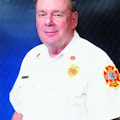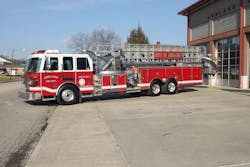Hazmat Studies: Ashland, KY, Regional Hazmat Team
Ashland, KY, is located on the southern bank of the Ohio River in northeastern Kentucky, across from West Virginia, just off of Interstate 64. Known as Kentucky's Country Music Capital, Ashland has a population of approximately 21,684 and covers an area of 10.8 square miles. Ashland is the largest city in Boyd County and is a part of the fifth-largest metropolitan area in Kentucky. Ashland, KY, Huntington, WV, and Ironton, OH, form a metropolitan tri-state area of more than 300,000 people. Ashland serves as an important economic and medical center for northeast Kentucky.
Early history
In 1878 Ashland was jarred awake by its first major fire. The fire swept through one of its leading business establishments along Front Street between 15th and 16th streets. The disaster was the catalyst for discussion among the community and its leaders for organizing a fire department and purchasing fire equipment. Little came from these discussions, and the city went on with little or no improvement.
Then in 1883 the wooden portions of the Norton Iron Works facility were destroyed by fire. The bucket brigade could not provide sufficient water to hinder the spread and destruction of the flames. The incident spawned discussion for changes in the way firefighting operations were conducted. The city had been hit hard enough, and the residents were ready for a change.
In 1885, the Ashland Fire Department (AFD) was founded as a volunteer fire department. The new department purchased a hand-drawn hook-and-ladder wagon and 24 rubber buckets. In later years, the city migrated away from a volunteer department to a full-time, paid organization, and purchased steam engines and hoses.
Since that time, the department has evolved and expanded into a group of dedicated personnel who not only extinguish fires but who also perform other specialized operations, such as medical assistance to EMTs, code enforcement, fire prevention, fire inspection, public safety education, smoke detector installations, various types of specialized rescue services, and hazardous materials response and mitigation.
Modern-day department
Today's AFD is led by Chief Scott Pennick. The department has 52 uniformed personnel and covers a city area of 12.1 square miles and a county area of 160 square miles for hazardous materials response, with an extended population of 50,000. Firefighters work a schedule of 24 hours on duty and 48 hours off duty. The AFD operates from three fire stations with four engines, one truck, two boats, one hazmat trailer and a mini-pumper brush unit. In addition to hazmat response, the department also has swiftwater, dive and rope rescue teams. The AFD responded to 1,632 requests for service in 2015. Of that, 199 were fires, 489 EMS/rescue, 58 hazardous materials and the remaining miscellaneous. EMS response and transport is provided by Boyd County.
Hazmat team
Ashland’s Regional Hazardous Materials Response Team was formed in 1992, when the department’s leaders saw the need in their jurisdiction for a local and regional response capability. Their first response vehicle was a tractor-trailer rig that carried response equipment.
Presently, Ashland utilizes a 24-foot Homesteader Trailer towed by a step-van. A hand-drawn decon cart is pre-loaded with decon equipment utilized by operations personnel who have been trained to perform decon activities.
The Hazardous Materials Team equipment and vehicles respond from their Central Station, which houses fire department administrative offices along with six drive-through apparatus bays. Hazardous materials PPE includes Scott SCBA with one-hour bottles. Level A chemical suits are manufactured by Lakeland Industries. Level B chemical suits are manufactured at Kappler Incorporated. They also carry assorted boots and gloves to complete the chemical protective equipment ensemble. Mass decon is accomplished with a Zumro Shelter/Decon Tent. Response equipment includes typical hazmat patching and leak-stopping equipment, including Chlorine Kits A and B and other tools and supplies to manage a hazmat incident. Monitoring equipment includes MultiRAE Plus gas detectors, mini carbon monoxide (CO) detectors, the HazMatID 360 command system, Drager CMS and ODS monitors, radiation monitors and Thermo Scientific (ESM Eberline) detector.
Training
Hazmat team members are required to take a 40-hour, in-house technician-level course developed by the Kentucky Community and Technical College System (KCTCS). All department firefighters are trained to the Technician Level. County firefighters are trained to the operations level, and trained to perform decon to assist the AFD on hazmat incidents.
Some AFD hazmat technicians have attended the Department of Energy’s (DOE) Nevada National Security Site (NNSS) biological/chemical classes at the Center for Domestic Preparedness (CDP), located in Anniston, AL. Others have attended the explosives classes at New Mexico Tech (EMRTC) and hazmat technician classes put on by the IAFF. Team members have also attended classes run by some of the local industries, including Marathon Refinery, DuPont Chemical, Calgon Chemical, AK Steel, Air Products and CXS railroad. These classes result in certifications on particular products or processes.
Ashland hazmat personnel also receive quarterly in-service training in house. Quarterly training has included an anhydrous ammonia training tanker with Marathon Oil Refinery. Hazmat team members were tasked with stopping a leak of ammonia simulated with smoke from a smoke machine. The theatrical smoke gave the appearance of ammonia vapors along the ground. Team members went through a full drill using Level A suits. They dressed out, investigated, had members apply the leak kit, sent them through decon, and had a debriefing afterward.
Hazmat response
Hazmat responses in Ashland include fuel spills, gas odors and leaks. Engine companies carry absorbents, CO detectors and MultiRAEs. If the company officer determines that they need the hazmat team for an initial response, they can call for the team. The hazmat team is not dedicated, but there are approximately 16 hazmat technicians on duty each shift. There are 52 hazmat technicians on the AFD.
Hazmat exposures
Ashland has several major U.S. highways in its response area that are transportation routes for hazardous materials, including U.S. Highways 23, 60 and Interstate Highway 64, along with various state and local roads. CSX Railroad has a line through its response area, and there is hazardous materials on barge traffic and at the Ohio River Marine Terminal. Pipelines also transport hazardous materials in and through Boyd County.
Major industries that manufacture or use hazardous materials include the Marathon Oil Companies –Catlettsburg Refining. It is the 26th largest refinery in the United States and a supplier of high-performance aviation fuels to the U.S. military. The refinery has its own fire brigade but receives aid from the AFD. Other major industries include AK Steel, Special Metals and Calgon Carbon, Inc. Additionally, Mark West Hydrocarbons distributes propane and butane by pipeline, tank truck and rail car. DuPont Chemical Company produces sulfuric acids, the number one volume chemical in the United States.
Incidents
- AFD responded to the Ashland Federal Correctional Institution for a suspicious powder in the mailroom. Hazmat personnel removed a couple of staff members and decontaminated them. Samples were taken of the substance for the prison so they could send it off to be tested and identified.
- Another incident involved a response to a barge, where some workers were overcome by chemicals used for cleaning a barge on the Ohio River. The injured workers were sent through decon and prepared to be transported by ambulance to the hospital.
- AFD has responded to several residences where a meth lab was present. Most of the time, their mission is to enter and test the air quality.
- Multiple responses have occurred at the local CXS railyard for tankers cars leaking hazardous materials. Most incidents involved chorine. The areas were secured and confirmation of the chemical was made. CSX then would then bring in a clean-up contractor to stop the leaks and provide any clean-up necessary.
- The department has also responded to clandestine dumping, where several discarded 55-gallon drums were dumped along a road. Efforts were made to identify the chemical(s) and mitigate as necessary. Most of the chemicals identified were non-hazardous.
- Chlorine leaks have also been reported at the city water treatment and sewage treatment plants. Hazmat personnel were tasked to stop leaks in some of their tanks and contain spills that have occurred.
- On July 30, 2011, a liquid oxygen leak occurred at Air Products, a local industrial facility. Ashland firefighters stood by and monitored the air quality around the plant while the leak was being repaired. Firefighters also sprayed water to keep the cloud from the releasing oxygen inside the perimeter of the plant. Oxygen becomes a gas once it hits the atmosphere. The oxygen that was released dissipated into the atmosphere, and there was no off-site hazard or environmental impact. Initially, oxygen is harvested from the air and placed in tanks through a cryogenic cooling process. The rail lines adjacent to the plant were also shut down. U.S. 23 was closed near the facility to minimize the risk of a fire or explosion from the elevated oxygen levels in the atmosphere. The leak that injured one Air Products employee was caused by a faulty valve. The employee suffered cryogenic burns on his hands and was taken to the Cabell Huntington Hospital burn unit for treatment. He was released the next day. Crews worked through the night to isolate the portion of the plant where the leak occurred so the valve could be replaced.
More information
For additional information or questions, please contact Deputy Chief Greg Ray at (606) 922-1433 or [email protected], or visit the AFD website at www.ashlandkyfire.org.
About the Author

Robert Burke
Robert Burke, who is a hazardous materials and fire protection consultant and who served as a Firehouse contributing editor, is a Certified Fire Protection Specialist (CFSP), Fire Inspector II, Fire Inspector III, Fire Investigator and Hazardous Materials Specialist. He has served on state and county hazmat teams. Burke is the author of the textbooks "Hazardous Materials Chemistry for Emergency Responders," "Counter-Terrorism for Emergency Responders," "Fire Protection: Systems and Response," "Hazmat Teams Across America" and "Hazmatology: The Science of Hazardous Materials."
